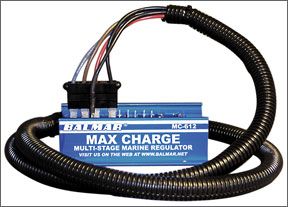I am building an electrical system that will hopefully support wife and two teenage daughters. With this objective, I am planning approximately 1,000-amp hour battery bank. I see lots of hype about the external three-stage voltage regulators. Do they really provide more amp hours during the limited engine running time? If so, I have not found any definitive side-by-side comparisons that convince me that three-stage regulation is more efficient than a single-stage constant voltage regulator. Brian Sandridge
Sandusky Harbor Marina, Ohio
Multi-stage external voltage regulators do not provide a higher amp-hour recharge rate than the simple internal regulator that is commonly found on standard engine

288
alternators. But the type of charge that external multi-stage regulators are designed to deliver makes them well worth considering when installing a deep-cycle house battery bank, even if your anticipated engine run time is minimal.
The acceptance rate in a charging cycle is how many amps a battery bank can tolerate at any given time. Multi-stage regulators keep the charge closer to this ampere level throughout the charge cycle, while conventional automotive type regulators taper the charge more abruptly. The latter technology was never intended to optimize charging over a short time span.
Three-stage external regulators like the Charles Industrys Next Step Series or Balmar Max Charge models have charge algorithms that are user-programmable to accommodate the various battery types on the market (lead acid, deep-cycle lead acid, AGM, gel, optima). Gel batteries, unlike lead-acid batteries, are very sensitive to charge voltages above 14.1 volts. With that being said, it is important to point out that the single-stage internal regulators found on most standard-grade alternators do not allow the user to adjust the voltage output.
In addition to the option of allowing the installer to choose the type of battery being recharged, most external regulators can accommodate battery temperature compensation (important for those sailing in the extreme latitudes). Some external regulator models even monitor the temperature of the alternator, issuing a command to ease up on the charge rate until the alternator cools down. The Balmars Max Charge series of regulators have a unique feature called soft voltage ramp up, whereby the maximum charge output rate of the alternator is slowly brought up online, reducing strain on the engine and belts. This feature goes a long way in reducing the slipping belt scream of a heavily loaded alternator.
Because multi-stage external regulators apply a smarter recharging regime, the life of a house battery bank likely would be extended by at least a season. When we factor in the high initial cost of a typical 1,000-amp hour deep-cycle battery bank and the possibility of extending the battery banks life, versus the $300 cost of a Charles or Balmar external regulator, we definitely find value in having an external voltage regulator installed on larger house battery banks.



































